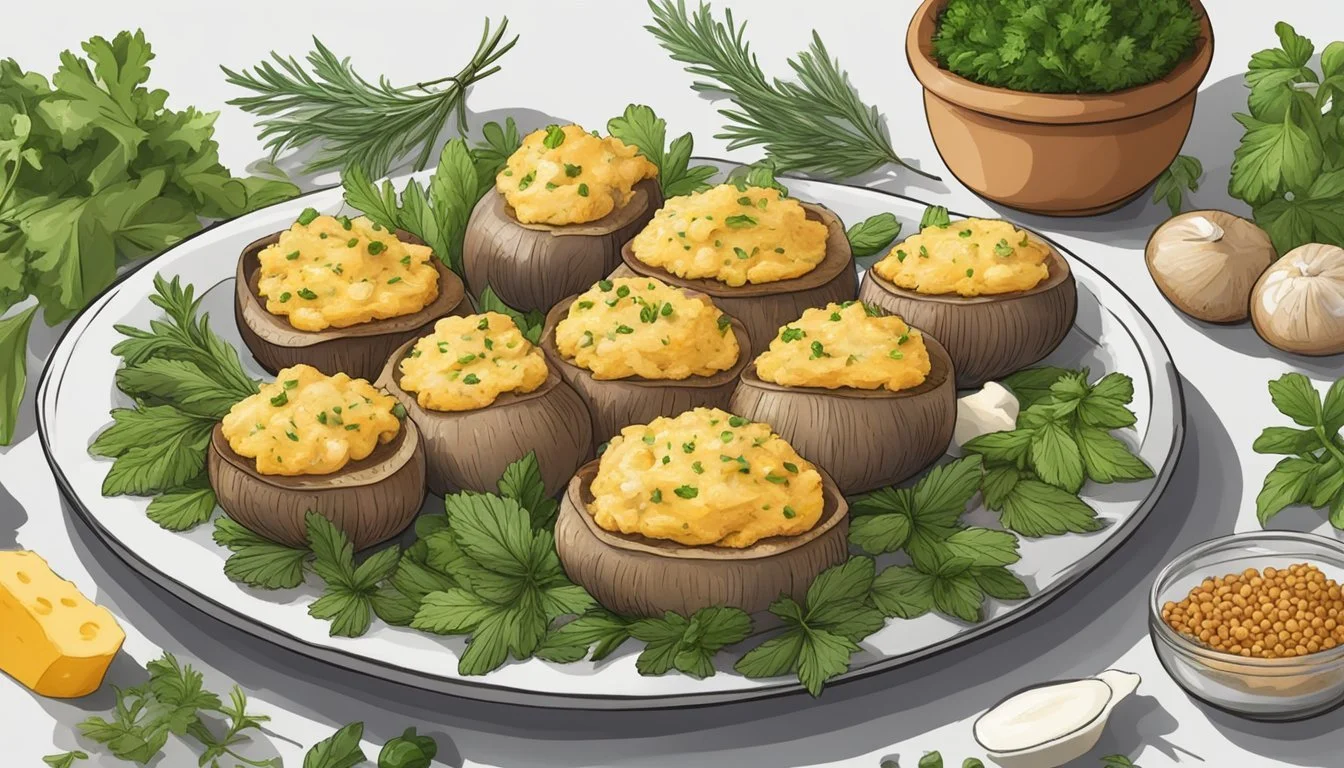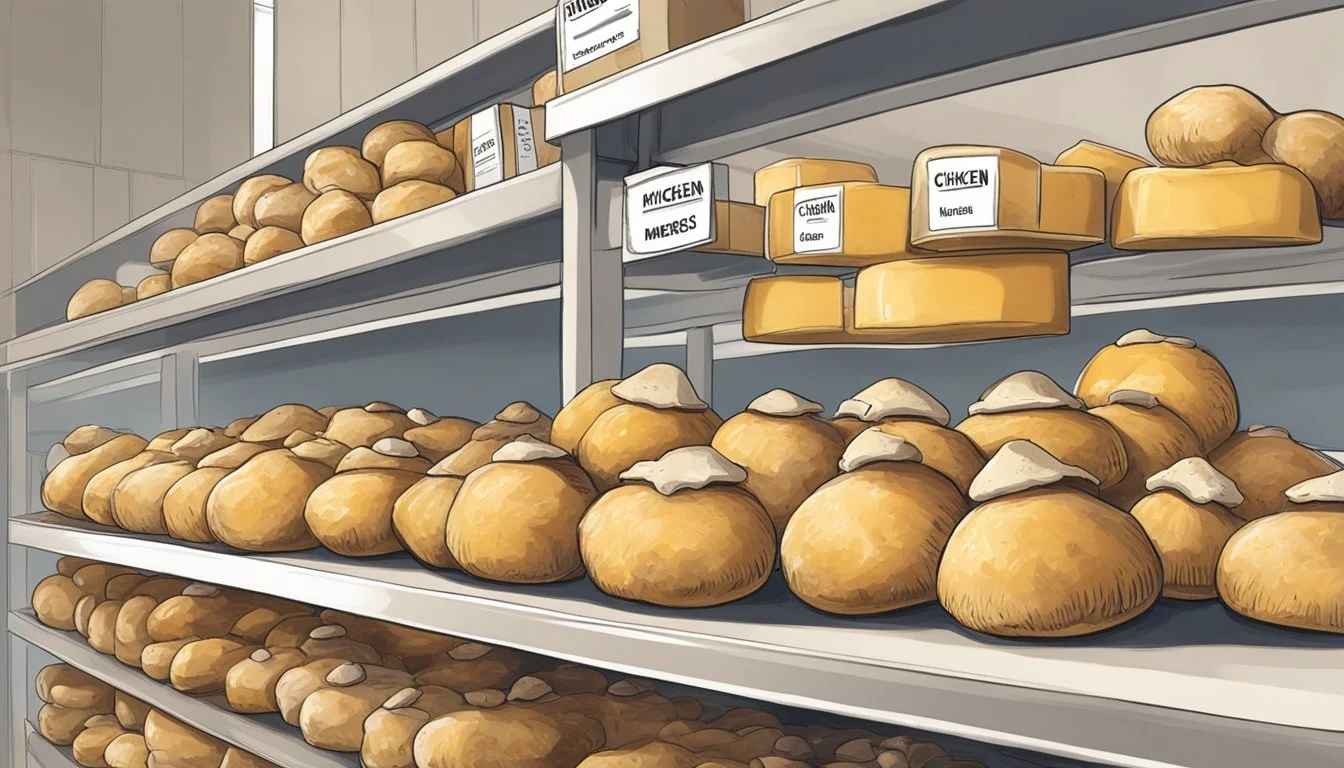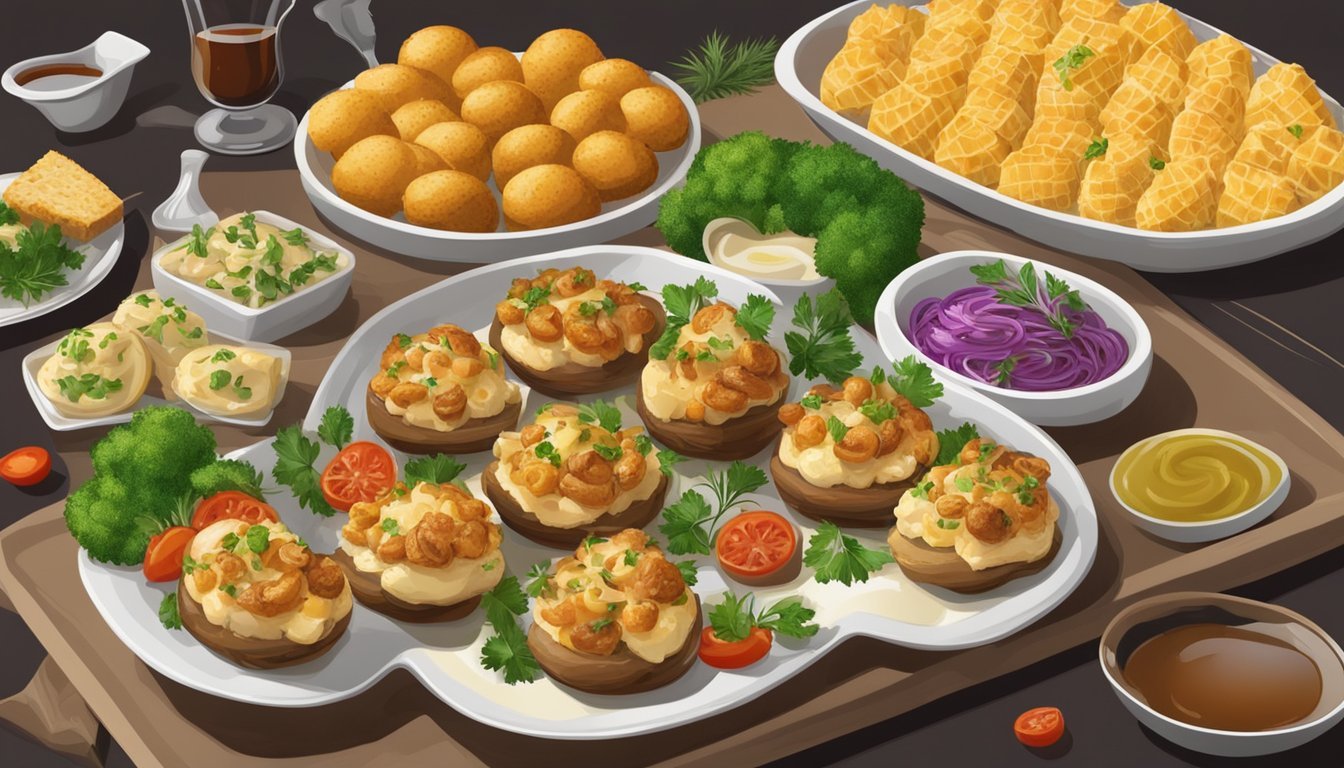How Long Do Chicken and Cheese Stuffed Mushrooms Last?
Storage Tips and Shelf Life
Chicken and cheese stuffed mushrooms are a delectable appetizer or side dish that many enjoy making for gatherings or simple family dinners. These stuffed mushrooms, with their savory mix of chicken, cheese, and spices, can elevate any meal with their rich and satisfying flavors.
Properly stored in an airtight container in the refrigerator, chicken and cheese stuffed mushrooms can last up to 3 to 4 days. To maintain their quality, it's important to refrigerate them within two hours of cooking. If you're planning to keep them longer, freezing can extend their shelf life up to two months.
Quality is key when it comes to enjoying leftovers, and reheating them properly ensures they remain just as delightful as when they were first made. Expert tips on storage and reheating can help preserve the taste and texture of your stuffed mushrooms, making each bite as enjoyable as the first.
Understanding Stuffed Mushrooms
Stuffed mushrooms stand out due to their versatile nature and rich blend of flavors, making them a favorite appetizer. Critical to making these delectable bites are the key components and the choice of mushroom varieties.
Components of Stuffed Mushrooms
Stuffed mushrooms typically consist of three main elements: caps, filling, and cheese. Mushroom caps are usually hollowed out to make room for the filling. Commonly used mushrooms like white button, cremini, and portobello offer a variety of textures and sizes.
The filling often includes ingredients such as chicken, cream cheese, mushroom stems, herbs, and spices. These ingredients are combined to create a rich and savory flavor profile. The meat and cream cheese add a creamy texture that pairs well with the earthy taste of mushrooms.
Finally, cheese like Cheddar, Mozzarella, or Parmesan is used to top the stuffed mushrooms. It melts during baking, forming a golden crust that enhances both the taste and appearance of the appetizers.
Varieties of Mushrooms
White button mushrooms are among the most popular choices for stuffing. Their size is manageable, making them perfect for bite-sized appetizers. Additionally, their mild flavor serves as a great canvas for various fillings.
Cremini mushrooms, also known as baby bella mushrooms, provide a slightly deeper flavor compared to white button mushrooms. They are slightly firmer and hold up well during cooking, making them suitable for more robust fillings.
Portobello mushrooms are much larger and can be used for main dishes rather than appetizers. Their wide caps and meaty texture make them ideal for heartier fillings that include larger chunks of chicken or vegetables. The richness of their flavor adds depth to any mushroom recipe.
Choosing the right mushroom variety can significantly impact the overall experience of the dish, enhancing both flavor and texture.
Preparing Your Stuffed Mushrooms
When preparing chicken and cheese stuffed mushrooms, choosing fresh ingredients, properly assembling them, and cooking them to the right consistency ensures delicious results.
Selecting Ingredients
Start with fresh mushrooms, ideally purchased the same day you plan to prepare the dish. Button mushrooms and cremini mushrooms work well for stuffing. Ensure the mushrooms are firm and not slimy. For the filling, use ground chicken or well-drained, finely chopped cooked chicken.
Other essential ingredients include cream cheese, parmesan cheese, and breadcrumbs. Consider adding fresh herbs like thyme or parsley, as well as spices such as black pepper, kosher salt, and Italian seasoning. A touch of garlic enhances the overall flavor profile.
Assembling the Mushrooms
Begin by cleaning the mushrooms with a damp cloth. Remove the stems and hollow out the caps to create space for the filling. In a skillet, sauté chopped onions, garlic, and the mushroom stems in olive oil or butter. Once soft, mix them with the chicken, cream cheese, and parmesan cheese in a bowl.
Season the mixture with salt, pepper, and Italian seasoning to taste. Using a spoon, evenly fill each mushroom cap with the mixture and top with breadcrumbs for extra crunch. For additional flavor, consider adding bacon bits or a sprinkle of fresh parsley.
Cooking Techniques and Times
Preheat the oven to 350°F (175°C). Arrange the stuffed mushrooms in a lightly oiled, shallow baking dish in a single layer. This prevents overcrowding and ensures even cooking.
Bake the mushrooms for around 10 to 12 minutes until the filling is bubbly and the tops are golden brown. For an extra crisp top, you can broil the mushrooms for an additional 1 to 2 minutes after baking.
Check that the internal temperature reaches 165°F (74°C) to ensure the chicken is fully cooked. Serve immediately for the best texture and flavor.
Storage and Shelf Life
Chicken and cheese stuffed mushrooms can remain safe and fresh if stored and handled correctly. Knowing the proper storage methods, signs of spoilage, and how to maximize freshness is essential.
Proper Storage Methods
Store chicken and cheese stuffed mushrooms in the refrigerator as soon as possible. Use an airtight container or wrap them tightly in plastic wrap to maintain moisture and prevent them from drying out.
Avoid using metal containers as they can affect the taste.
Fully cooked stuffed mushrooms can last three to four days when properly stored. For uncooked mushrooms, the shelf life is generally shorter as raw ingredients have a limited usable time.
Signs of Spoilage
Look for a slimy texture on the mushrooms; this indicates they are no longer safe to eat. An unpleasant or sour odor is another clear sign of spoilage.
Discoloration, particularly a darkened or blotchy appearance, also points to spoilage.
Discard any stuffed mushrooms showing these signs to avoid foodborne illnesses.
Maximizing Freshness
Refrigerate stuffed mushrooms immediately after cooling. Keep them in the coldest part of the refrigerator to extend their shelf life.
To reheat, use an oven or microwave, ensuring the internal temperature reaches at least 165°F to kill any harmful bacteria.
Avoid reheating multiple times as this can degrade the quality and safety. Use fresh ingredients when preparing stuffed mushrooms, and consume them within the recommended storage timeframe.
Nutritional Considerations
Chicken and cheese stuffed mushrooms provide a flavorful and satisfying dish. Key nutritional aspects include calorie content, as well as the balance of macronutrients and essential micronutrients.
Calorie Content
Chicken and cheese stuffed mushrooms typically have a moderate calorie count due to the ingredients used.
An average serving (approximately two to three medium-sized stuffed mushrooms) usually contains around 200-300 calories.
Factors affecting calorie content include the type and amount of cheese, the amount of chicken, and any additional fillings or toppings used. Cooking methods such as baking or frying can also influence the total calorie content.
Macronutrients and Micronutrients
These stuffed mushrooms are a good source of protein, primarily from the chicken. A typical serving can provide 15-20 grams of protein.
The cheese adds a mix of fats, often contributing around 10-15 grams of total fat per serving.
Carbohydrates in the dish are minimal, generally coming from any added vegetables or breadcrumbs, if used.
Water content in the mushrooms themselves aids in keeping the dish relatively low in carbs and calories.
Essential micronutrients include calcium and phosphorus from the cheese, as well as vitamins B6 and B12 from the chicken.
Stuffed mushrooms are generally gluten-free, making them suitable for those with gluten sensitivities, provided no gluten-containing ingredients are added.
Seasonings such as salt, pepper, and herbs can enhance flavor without significantly impacting nutrition.
Serving and Presentation
Chicken and cheese stuffed mushrooms are a crowd-pleaser for parties and gatherings. Their versatility in pairing with other dishes and the ease of serving make them an excellent appetizer choice.
Pairings and Accompaniments
Stuffed mushrooms pair well with a variety of side dishes and beverages. Fresh salads with crisp vegetables provide a balanced contrast to the savory mushrooms. Sausage or shrimp can be included in the stuffed mushroom recipe for an extra layer of flavor.
For a complementary beverage, white wine or a light beer enhances the taste of the cheese and chicken mixture. Additionally, arranging the mushrooms with other appetizer recipes such as crab cakes or keto-friendly bites can create a diverse and inviting spread.
Serving Size and Plating
Typically, serving two to three stuffed mushrooms per guest is a good rule of thumb. This quantity allows guests to enjoy the appetizer without it being too filling. Placing the mushrooms on a large platter with a garnish of fresh parsley or basil adds a touch of color and freshness.
For an elegant presentation, serve the stuffed mushrooms warm. Use toothpicks for easy handling at parties. To prevent them from drying out, consider covering the serving tray with foil until serving time. Additionally, using a combination of white mushrooms and portobello mushrooms can add visual interest and cater to different tastes.
These steps help ensure that the mushrooms are both appealing and easy to eat, fitting seamlessly into various appetizer settings.
Tips and Tricks for Perfect Stuffed Mushrooms
Achieving the best stuffed mushrooms involves understanding the common pitfalls, enhancing their flavors, and planning your preparation schedule effectively. Below are insights into solving specific issues, boosting taste and texture, and making them ahead of time.
Troubleshooting Common Problems
Mushy Mushrooms: Avoid overcooking to prevent soggy mushrooms. Bake them at 350°F for 20-25 minutes, checking for tender caps and golden tops.
Filling Falling Out: Secure the filling by packing it tightly into the caps. Opt for ingredients that bind well, such as breadcrumbs and cheese.
Bland Taste: Season the mushrooms and filling generously. Salt, pepper, and herbs like rosemary can significantly enhance flavor.
Enhancing Flavor and Texture
Cheese Selection: Use a mix of cheeses like Parmesan for sharpness and mozzarella for creaminess. This dual approach ensures a balanced, flavorful filling.
Fresh Ingredients: Opt for fresh parsley, garlic, and onions to bring out more robust and aromatic profiles. These simple additions elevate the overall taste.
Add-Ons: Consider adding finely chopped crab meat or leftover chicken to your stuffing mix. These proteins add a delicious element to the dish and make it more substantial.
Making Stuffed Mushrooms in Advance
Preparation: Prepare the filling and stuff the mushrooms up to a day in advance. Store them in the fridge, covered, until ready to bake.
Baking: If making ahead, bake them directly from the fridge. Allow an additional 5 minutes of baking time to account for the cold start.
Storage: Leftovers, when stored in an airtight container, can last up to 3 days in the fridge. They can be reheated in the oven at 300°F until warmed through.
By following these tips and tricks, you can ensure that your stuffed mushrooms are consistently delicious and perfect for any meal or party.
Adapting the Recipe for Dietary Restrictions
Making chicken and cheese stuffed mushrooms suit various dietary needs can be straightforward with the right ingredient swaps. This guide explores options for gluten-free, low-carb, vegetarian, vegan, and dairy-free diets.
Gluten-Free and Low-Carb Options
For a gluten-free twist, replace traditional breadcrumbs with gluten-free breadcrumbs or crushed gluten-free crackers. Almond flour or ground pork rinds can be used to keep the dish low-carb and keto-friendly.
Swapping out yellow onion shavings instead of traditional onions can also enhance flavor without adding carbs. Using mozzarella cheese made from whole milk ensures compliance with keto guidelines due to its high-fat content.
Vegetarian and Vegan Alternatives
To make the dish vegetarian, eliminate chicken and increase the quantity of sautéed veggies. Mushrooms, bell peppers, and spinach work well.
For a vegan variation, replace dairy cheese with vegan cheese alternatives made from nuts or soy. Nutritional yeast can substitute parmesan cheese to maintain a cheesy flavor profile. Tofu crumbles or lentils can be used instead of chicken, as they absorb flavors well.
Dairy-Free Variations
For a dairy-free version, replace the mozzarella cheese and cream cheese with non-dairy alternatives. Options include cashew cheese, almond-based cheese, or coconut-based cheese. Use dairy-free breadcrumbs to keep the texture crispy.
When adapting recipes like chicken stuffed mushrooms from sources like Natasha's Kitchen, always check ingredient lists to ensure all items comply with dietary restrictions. Red pepper flakes and dried thyme can be used to add spice and aroma without any dairy or gluten components.
Adapt these recipes not only to meet dietary needs but also to maintain flavor and texture, making them a hit at any gathering.









